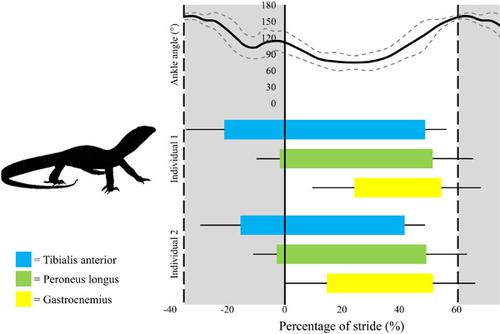当前位置:
X-MOL 学术
›
J. Exp. Zool. Part A
›
论文详情
Our official English website, www.x-mol.net, welcomes your feedback! (Note: you will need to create a separate account there.)
Testing the propulsive role of m. peroneus longus during quadrupedal walking in Varanus exanthematicus.
Journal of Experimental Zoology Part A ( IF 2.8 ) Pub Date : 2020-04-15 , DOI: 10.1002/jez.2361 Michael C Granatosky 1
Journal of Experimental Zoology Part A ( IF 2.8 ) Pub Date : 2020-04-15 , DOI: 10.1002/jez.2361 Michael C Granatosky 1
Affiliation

|
Some varanid lizards show a prominent and highly distinctive lateral calcaneal process. It has been posited that this structure serves as a lateral “heel” to increase the moment arm for m. peroneus longus, allowing it to function as a powerful propulsive muscle. However, to confirm that m. peroneus longus serves this function requires electromyographic data showing activity during tarsal plantarflexion in the late part of the stance phase. Muscle activity patterns of m. peroneus longus, m. tibialis anterior, and mm. gastrocnemii were collected from two savannah monitors (Varanus exanthematicus) during quadrupedal walking. Across strides, m. peroneus longus shows an early onset just before hindlimb touchdown and an offset that is highly correlated with that of mm. gastrocnemii. These patterns are consistent across individuals. However, the fact that the first onset of m. peroneus longus appears to be around the end of swing phase, with activity continuing throughout the remainder of stance, suggests that this muscle likely serves other functional purposes during locomotion beside propulsion. This, paired with the fact that qualitative comparisons of m. peroneus longus activity across other lizard species reveal remarkably similar patterns, suggests the propulsive role of m. peroneus longus in V. exanthematicus was probably built upon existing muscle activity patterns present in ancestral squamates and then exaggerated through modifications to lateral calcaneal heel and the associated proximal expansion of the fifth metatarsal.
中文翻译:

测试m的推动作用。在四肢走动在varanus exanthematicus中的长骨。
一些瓦拉尼蜥蜴显示出突出且高度独特的侧跟骨突。假设该结构用作横向“后跟”以增加力矩臂m。腓骨长肌,使其具有强大的推进力。但是,要确认m。腓骨长直肌起着这项功能,需要肌电图数据显示姿态期后期骨plant屈期间的活动。米的肌肉活动模式。长骨腓骨 胫前肌和毫米。腓肠肌是从两个大草原监测器(Varanus exanthematicus)在四足行走中。跨步,米。腓骨长肌在后肢触地之前显示出较早的发作,其偏移量与mm高度相关。腓肠肌。这些模式在个体之间是一致的。但是,事实是第一个发病期为m。腓骨长肌似乎处于挥杆阶段的末尾,在其余的姿势中活动持续进行,这表明该肌肉可能在运动过程中除推进作用外还发挥其他功能作用。这与m的定性比较相吻合。其他蜥蜴物种的腓骨长寿活动显示出非常相似的模式,表明m的推动作用。圆锥形伏牛长骨 可能是基于祖先鳞状细胞中现有的肌肉活动模式,然后通过修饰外侧跟骨跟骨和相关的第五meta骨近端扩张来夸张。
更新日期:2020-04-15
中文翻译:

测试m的推动作用。在四肢走动在varanus exanthematicus中的长骨。
一些瓦拉尼蜥蜴显示出突出且高度独特的侧跟骨突。假设该结构用作横向“后跟”以增加力矩臂m。腓骨长肌,使其具有强大的推进力。但是,要确认m。腓骨长直肌起着这项功能,需要肌电图数据显示姿态期后期骨plant屈期间的活动。米的肌肉活动模式。长骨腓骨 胫前肌和毫米。腓肠肌是从两个大草原监测器(Varanus exanthematicus)在四足行走中。跨步,米。腓骨长肌在后肢触地之前显示出较早的发作,其偏移量与mm高度相关。腓肠肌。这些模式在个体之间是一致的。但是,事实是第一个发病期为m。腓骨长肌似乎处于挥杆阶段的末尾,在其余的姿势中活动持续进行,这表明该肌肉可能在运动过程中除推进作用外还发挥其他功能作用。这与m的定性比较相吻合。其他蜥蜴物种的腓骨长寿活动显示出非常相似的模式,表明m的推动作用。圆锥形伏牛长骨 可能是基于祖先鳞状细胞中现有的肌肉活动模式,然后通过修饰外侧跟骨跟骨和相关的第五meta骨近端扩张来夸张。


























 京公网安备 11010802027423号
京公网安备 11010802027423号